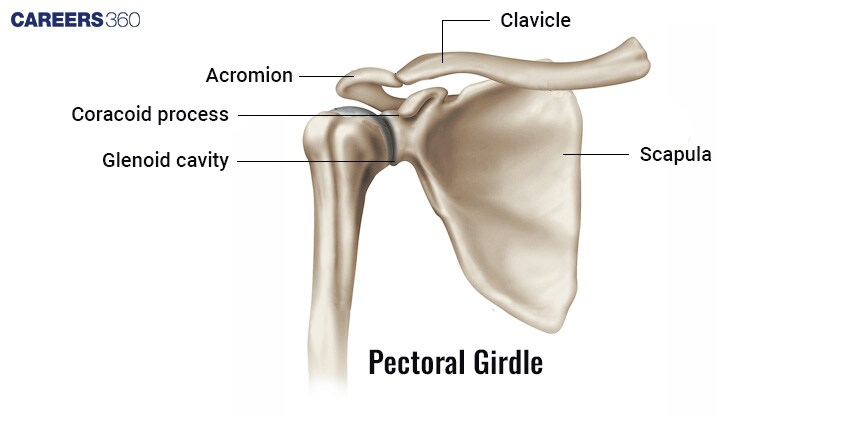Pectoral Girdle: Description, Anatomy, Function, Diagram
What Is Pectoral Girdle?
The pectoral girdle, also known as the shoulder girdle, is composed of clavicles and scapulae. The structure it forms provides for attaching the upper limbs to the trunk. Thus, it becomes a vital part of human anatomy that provides attachments for muscles to facilitate arm movements and ranges of motion required for activities of the upper limbs. For activities that involve arm and shoulder mobility, what is essential is merely the basic structure of the pectoral girdle, providing freedom for movement in all directions.
NEET 2025: Mock Test Series | Syllabus | High Scoring Topics | PYQs
NEET Important PYQ's Subject wise: Physics | Chemistry | Biology
New: Meet Careers360 B.Tech/NEET Experts in your City | Book your Seat now
- What Is Pectoral Girdle?
- Anatomy Of The Pectoral Girdle
- Joints of the Pectoral Girdle
- Muscles That Articulate At The Pectoral Girdle
- Nerve Supply To The Pectoral Girdle
- Blood Supply To The Pectoral Girdle
- Biomechanics Of The Pectoral Girdle
- Common Disorders And Injuries
- Recommended Video On ‘Pectoral Girdle’

Anatomy Of The Pectoral Girdle
The pectoral girdle has two general bones. These are:
Clavicle (Collarbone)
S-shaped bone between the sternum and the scapula.
Acts as a strut to hold the scapula in place, thereby providing for movement of the arm.
Common Injuries: Fractures; most commonly as the result of falls or direct blows.
Scapula (Shoulder Blade)
Flat, triangular bone on the posteri¬or side of the ribcage.
Offer attachment points for a good number of muscles involved actively in the movements of the arm.
Common Injuries: Dislocations.
Diagram: Pectoral Girdle

Joints of the Pectoral Girdle
The joints of the pectoral girdle include:
Sternoclavicular Joint
Synovial articulation between the sternum and clavicle.
Allow swinging motion of the clavicle in multiple planes.
Acromioclavicular Joint
The articulation between the acromion of the scapula and the clavicle.
It helps in the movement of the scapula, thus providing flexibility to the shoulder.
Glenohumeral (Shoulder) Joint
Ball and socket joint between the scapula and the humerus.
Allow for a large range of motion for the arm.
Range of Movement: Flexion, extension, abduction, adduction, and rotation.
Muscles That Articulate At The Pectoral Girdle
Among the long list of muscles articulating at the pectoral girdle, one finds the following:
Pectoralis major and minor
Deltoid
Trapezius
Serratus Anterior
Rhomboid Major and Minor
These muscles offer stability and maintenance of the position of the scapula and clavicle during upper limb movements.
Nerve Supply To The Pectoral Girdle
The nerve supply to the pectoral girdle allows muscle function and sensation. These include:
Major Nerves
Brachial Plexus
Suprascapular Nerve
Axillary Nerve
Long Thoracic Nerve
Blood Supply To The Pectoral Girdle
Blood supply to the pectoral girdle allows for the delivery of oxygen and nutrients to the bones and muscles. These include:
Major Arteries
Subclavian Artery
Axillary Artery
Brachial Artery
Biomechanics Of The Pectoral Girdle
The biomechanics of the pectoral girdle provide for complex motions around the upper limb:
Flexion, Extension, Abduction, Adduction
Rotation (Medial and Lateral)
Role in activities like lifting, pushing, and pulling.
Coordination between the muscles and joints in the pectoral girdle is essential for forming energetic and powerful movements.
Common Disorders And Injuries
The pectoral girdle is susceptible to various forms of disorders and injuries, which include:
Injuries
Fractures of Clavicle: This is the most common type and is generally caused by falls or direct impacts.
Dislocated Shoulders: Most commonly caused by trauma or through the excessive application of force excessively.
Rotator Cuff Tears: Generally, this kind of injury occurs because of overuse or acute injury.
Disorders
Shoulder Impingement Syndrome: It is essentially the compression of rotator cuff tendons.
Frozen Shoulder (Adhesive Capsulitis): Stiffness and pain in the shoulder joint.
Bursitis: The bursa becomes inflamed; this is usually the result of repetitive motion.
Recommended Video On ‘Pectoral Girdle’
Frequently Asked Questions (FAQs)
The pectoral girdle, formed by the clavicle and scapula, provides attachment of the upper limb to the axial skeleton and thus allows for various movements of the shoulder.
The two long bones that make up major parts of the pectoral girdle are the clavicle, or collarbone, and the scapula, or shoulder blade.
Injuries as minor as fractures to the clavicle, or paralysis as dislocation of the shoulder can lead to loss of motion and be inclusive of medical involvement for recovery and restoration of functions.
The prime contributors are the pectoralis major and minor, deltoid, trapezius, serratus anterior, and rhomboid muscles, each of which participates differently during every kind of action on the shoulder or arm.
This would involve Physiotherapy, and in some cases, even surgery, accompanied by subsequent exercises to regain strength, flexibility, and range of motion.
Also Read
30 Nov'24 06:17 PM
28 Nov'24 05:27 PM
28 Nov'24 04:14 PM
28 Nov'24 03:07 PM
28 Nov'24 03:06 PM
28 Nov'24 01:21 PM
28 Nov'24 12:16 PM